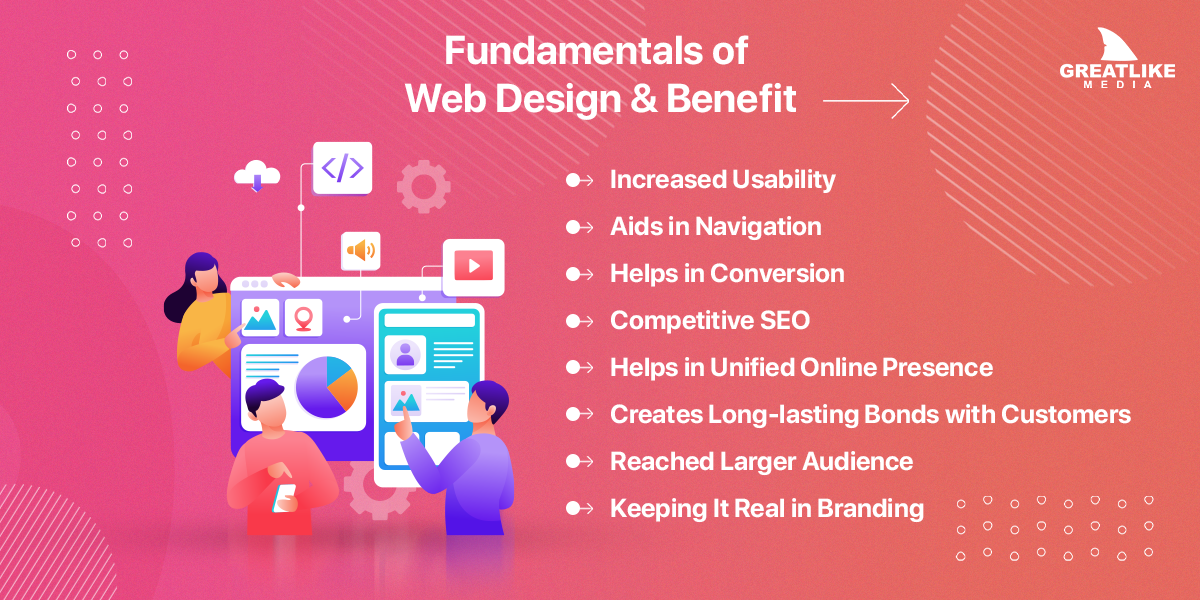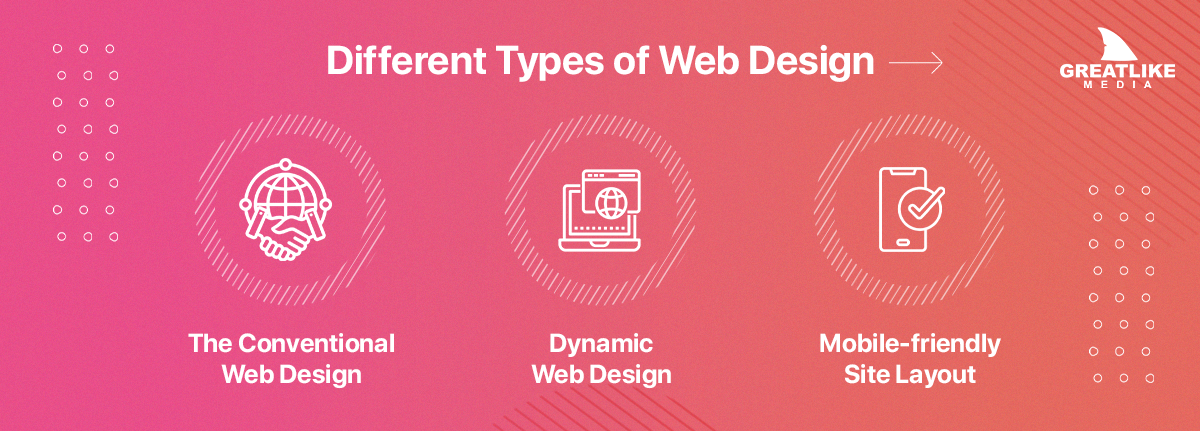
September 25, 2023
Does A Professional Web Design Matter?
Almost every modern business cannot succeed without a sleek and user-friendly website. Because your success or failure in the online world will have a direct effect on your bottom line. Is it enough to just have a website developed, or do you need something more elaborate?
It might be intimidating for a small business to put money into a professionally built website if they are struggling financially or have little technological skills. Whether your present site still serves its purpose but seems dated, you may wonder whether it’s time for a redesign.
The design of your company’s website impacts customer experience, lead generation, and revenue, as shown by ongoing research and studies.
Why You Should Care About Web Design?
Customers put a lot of value on style, which is another reason why the look of your website is so important. Whether we know it or not, beautiful design has a way of drawing us in. Studies have shown over and over that the design of your website has a big effect on how people see your business, and that if your site is badly made, people are more likely to leave it.
One study found that 75% of people only looked at a brand’s appearance to decide if they could trust it. What does it say about the company it serves if its website looks old?
You could have questions about how reliable they are, be worried about the services they offer, or even look for comfort on the website of a business that is in direct competition with them. But the study shows that the look of a company’s website has a big effect on how we feel about it at first.
One study found that 94% of people’s views of a healthcare provider were affected by how nice their website looked. The way your website looks can either attract or turn off people. Even though the data for this study came from the websites of healthcare companies, the findings can be applied to other businesses as well.
How to Define “Good Design”?
There is, of course, room for each person to see a design in their own way, but studies have shown that there is also a lot of stability in how we see designs. Both science and psychology back up the idea that all people like things that look nice and make them feel good when they are designed well.
Color, shape, and size are all things that all patterns have in common. The aesthetic language of a well-designed object is made up of these parts.
This is very clear in the English language. We talk to each other by using words, sentences, and symbols that follow writing and language rules. Some people use English better than others, and your grade school teacher probably told you that there is a clear difference between “good English” and “bad English.”
Your website might be either “good design” or “bad design,” just as there are both. Although visual communication is a core skill for web designers, not everyone has mastered it. That’s why it’s so important to invest in a site layout that not only looks great but also gets your message across effectively.
Why Website Design Is Crucial?
In the modern business environment, professional web design is crucial. Your website is often the first chance you have to make a first impression on potential customers in a world where first impressions are essential and competition is fierce.
A customer’s response to your website is indicative of their overall opinion of your company. What counts is whether or not your website converts visitors into paying customers.
Initial funding for a web design firm may seem like a lot, but it will pay off in the long run. Websites that are difficult to navigate or don’t seem professional will be ignored. The news of your company and its offerings will spread.
You need to invest in high-quality professional web design services if you’re serious about growing your company. In the long term, success is certain for this company venture.
Given that customers value aesthetics, how does your website’s design impact the user experience? Let’s examine some of the fundamentals of web design and how they could benefit your site.

1. Usability is increased
The usability of your website is measured by how quickly and easily your target audience can find what they’re looking for. Research shows that 86% of your website visitors want to see product or service information, 65% look for contact information, and 52% seek an About page for your business.
You may lose clients and cause frustration if you don’t make these things easy to get. Common web design guidelines dictate that you include your most important service and your contact information prominently.
Even if your website works well, users may have trouble navigating it or locating the information they need. Web design is a factor in how helpful people think a website is.
2. Aids in navigation
The navigation of your site is one of its most important characteristics, thus designing it well is essential. Hick’s Law is often used in this context since it considers the psychological factors that influence design.
According to Hick’s Law, giving someone a wide variety of choices will make them more deliberate in making a decision. Some people always associate it with “Keep it simple, stupid.”
We will do the same in accordance with Hick’s Law, which states that users should be presented with as few choices as possible throughout the website’s navigation process. A good rule of thumb is to limit the number of options to no more than seven.
3. Helps in conversion
You need to use decent web design if you want to get people to pay attention to what you want them to see. Designing your website with visible offers, calls to action, and readily clicked sections will increase conversions. Users may carry out the intended actions due to all of these causes.
There are several methods for improving visual conversion rates, and we’ll go through some of the more common ones here:
-
White space
One of the most efficient ways to get site visitors to click on your call to action is to leave plenty of white space around it. White space is an inappropriate topic to discuss without mentioning Apple.
This iPhone, for example, is emblematic of its signature minimalist style, which favours big areas of blank space and straightforward designs. The prompt to take action is quite clear: they want you to make a phone click since there is so little else going on.
-
CTA
On the other hand, think of a store like Amazon. Even though this page is packed with information and options, the bright “Add to Cart” button is always easy to see. Even on a busy website, the call to action button stands out because of the use of contrasting colours and fonts.
-
Professionalism
As we’ve already shown, your website’s aesthetics will influence the opinions of 74% of your visitors on the credibility of your business. When designs are modern and well-executed, people tend to have more faith in them.
If your website is poorly built, potential customers can start to doubt your legitimacy. Which business would you trust more if, say, you were looking to buy a used car?
-
Enhanced Homepage
One way in which trustworthy websites are developed is by keeping the brand’s visual identity constant. If your company is well-known, customers will certainly remember distinctive aspects of your brand like its logo, colour scheme, or overall style. Your website’s design should reflect your brand’s values and inspire confidence in returning consumers.
4. Competitive SEO
Finally, good website design extends deeper than meets the eye. What happens in the background in terms of design has a major influence on search engine optimization.
If a website takes forever to load because of sloppy coding or big images, the design’s aesthetics are irrelevant. There will be a negative impact on SEO as a result of this. It’s easy for web designers to get carried away with dazzling visuals and cutting-edge technologies that excite visitors but slow down a site’s performance.
5. Helps in a unified online presence
Web design and web development are two very different disciplines. Your website’s aesthetics and functionality are both crucial. There is a direct link between website traffic and performance.
Moreover, visitors are less inclined to come back to a site that seems unprofessional. Both web design and development contribute to a unified online identity for your business.
6. Creates long-lasting bonds with customers
Web design and development, by facilitating interaction with your demographic, may increase your likelihood of retaining existing customers. A high-quality website is essential if you want to establish long-term relationships with your clients.
The design and development of your website are what make you stand out from the crowd. No matter how great your product or service is, customers won’t purchase from you if they can’t find it on your website.
7. A larger audience may be reached
Anyone who has a question and an online link can find the answer they need. It’s not always simple to read or move around on a computer. If you hire a web writer and a web artist to work on your site, you might be able to get more people to use it.
Sites that are easy for people with disabilities to use, whether they have trouble seeing, hearing, thinking, moving, or speaking (or a mix of these), may help them a lot. Because of this change, they may offer you several ways to reach more people.
The creation and growth of websites are the most important parts of any good marketing campaign. Web development is the science of keeping up with business trends, while web design is the art.
A webpage could be like a digital business card. To get people, you need to plan, create, and build things carefully. You can also market and sell your goods and services through a website.
8. Keeping It Real in Branding
Many people’s initial exposure to a business is via its website. It represents who you are as a company and how trustworthy you are. The quality of your website’s design and development may make or break your company’s reputation.
Web design is concerned with the visual aspects of a website, as opposed to web development, which prioritizes the functioning of a site. Web designers shouldn’t make users work too hard to have a good time on their sites. Instead, it falls to on-site developers to ensure data integrity via safeguards like encryption and regular backups.
Different Types of Web Design
There are three main ways to create a website today: static, dynamic, and responsive. Static web design, the most basic kind, is typical of online portfolios. Since it takes more time and effort, dynamic web design is often reserved for more complex and elaborate website layouts. Responsive web design is the most advanced solution for websites that need to be seen on a broad range of devices.

A. The Conventional Web Design:
Static web design is the bare-bones choice for developing a website. It mostly relies on text links to other websites and has few images.
B. Dynamic Web Design
Making a website dynamic requires just a few more steps than a static one. Text documents, images, and other media are all examples of information that may be kept in “layers” of data. Engaging content such as articles, images, and other pages may be seen by visitors to a dynamic website.
C. Mobile-friendly site layout
In comparison to static or dynamic websites, responsive websites are media-rich and can adjust to the screen size of almost any mobile device. The impression made on a potential consumer by your website might be lasting.
Your website may be losing consumers because it seems dated, is difficult to use, or is just subpar in comparison to those of your competitors. Professional web design is essential if you want your website to attract visitors and stand out from the competition.
What Caused the Shift in Web Development?
Since its beginnings in the 1960s, the Internet has come a long way. When the World Wide Web was young, its usefulness was more important than how it looked. If people didn’t have to wait so long for pages to load, more time could be spent making websites look nice.
The wide use of HTML5 and CSS3 around the turn of the decade helped this change. The evolution of web development made possible by today’s computer languages has resulted in websites that are more accessible and interoperable with more devices than ever before.
In recent years, web design has become more important to the success of a website. The number of people who visit a website increases when it is both simple to navigate and visually beautiful. If you want a site that does credit to your brand and yields quantifiable results, you should hire a professional web design business.
Conclusion
It’s important to think about the site as a whole while designing it. Attracting new customers requires a well-designed, user-friendly website. If leads are appropriately followed up on, conversion rates might rise. More importantly, it guarantees that site visitors will have a positive experience and easily navigate your site.
It’s crucial to thoroughly investigate any potential designers to provide an accessible website for all users. Regular examination and modifications may increase your site’s indexability and accessibility in search engines.
 Back to main posts
Back to main posts